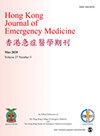Prone positioning in non-intubated patients with coronavirus – A single-centre experience in Hong Kong
IF 0.8
4区 医学
Q4 EMERGENCY MEDICINE
引用次数: 2
Abstract
Introduction: Significant ventilator-associated pneumonia and mortality were found in COVID-19 patients who required mechanical ventilation which calls for non-invasive means in managing respiratory failure. Methods: We retrospectively reviewed patients admitted to the intensive care unit of Pamela Youde Nethersole Eastern Hospital in Hong Kong with severe acute respiratory syndrome coronavirus 2 infection from 28 November to 15 December 2020. Patients’ laboratory, respiratory parameters and outcome data were recorded and analysed. Results: Eleven received prone ventilation. The median age was 67 (inter-quartile range: 59–72) years, and median COVID-19 GRAM score was 151 (inter-quartile range: 133–181), representing a high-risk group. There were significant improvements 1 h after awake proning in SpO2 (95% vs 92%, p = 0.008), FiO2 (0.4 vs 0.5, p = 0.003), SpO2/FiO2 (240 vs 184, p = 0.005), respiratory rate (19 vs 26, p = 0.006) and respiratory rate – oxygenation index (13.22 vs 7.67, p = 0.003; Table 1). Although not reaching statistical significance, the median PaO2, PaCO2 and PaO2/FiO2 improved after proning. The overall intubation rate was 22% and intensive care unit mortality was 22%, which is in contrast to 65.5% and 27.6%, respectively, in the first three waves. Although did not reach statistical significance, those received prone ventilation tend to have a lower ICU mortality (9.1% vs 42.9%, p = 0.245) and hospital mortality (18.2% vs 42.9%, p = 0.326). Conclusion: Awake proning potentially minimizes complications from invasive ventilation and provides a low-cost low-risk treatment option in COVID-19 patients with respiratory failure. This is particularly important when healthcare resources are strained at times of a pandemic.冠状病毒非插管患者的俯卧位-香港单一中心的经验
在需要机械通气的COVID-19患者中发现了明显的呼吸机相关肺炎和死亡率,这需要非侵入性手段来治疗呼吸衰竭。方法:回顾性分析2020年11月28日至12月15日香港东区尤德夫人那打素医院重症监护室收治的冠状病毒2型严重急性呼吸综合征患者。记录和分析患者的实验室、呼吸参数和结局数据。结果:11例患者接受俯卧位通气。年龄中位数为67岁(59-72岁),COVID-19 GRAM评分中位数为151分(133-181分),属于高危组。醒后1 h SpO2 (95% vs 92%, p = 0.008)、FiO2 (0.4 vs 0.5, p = 0.003)、SpO2/FiO2 (240 vs 184, p = 0.005)、呼吸速率(19 vs 26, p = 0.006)和呼吸速率-氧合指数(13.22 vs 7.67, p = 0.003;表1).中位PaO2、PaCO2和PaO2/FiO2均改善,但未达到统计学意义。总体插管率为22%,重症监护病房死亡率为22%,而前三波分别为65.5%和27.6%。虽无统计学意义,但俯卧位通气组ICU死亡率(9.1% vs 42.9%, p = 0.245)和住院死亡率(18.2% vs 42.9%, p = 0.326)均较低。结论:清醒倾向可最大限度地减少有创通气并发症,为COVID-19呼吸衰竭患者提供低成本、低风险的治疗选择。当大流行期间卫生保健资源紧张时,这一点尤为重要。
本文章由计算机程序翻译,如有差异,请以英文原文为准。
求助全文
约1分钟内获得全文
求助全文
来源期刊

Hong Kong Journal of Emergency Medicine
EMERGENCY MEDICINE-
CiteScore
1.50
自引率
16.70%
发文量
26
审稿时长
6-12 weeks
期刊介绍:
The Hong Kong Journal of Emergency Medicine is a peer-reviewed, open access journal which focusses on all aspects of clinical practice and emergency medicine research in the hospital and pre-hospital setting.
 求助内容:
求助内容: 应助结果提醒方式:
应助结果提醒方式:


